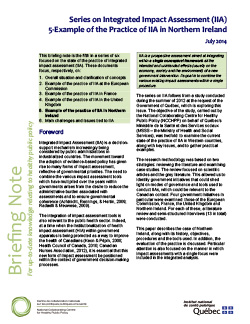Series on Integrated Impact Assessment (IIA): 5-Example of the Practice of IIA in Northern Ireland
This briefing note is the fifth in a series of six focused on the state of the practice of integrated impact assessment (IIA). These documents focus, respectively, on:
- Overall situation and clarification of concepts
- Example of the practice of IIA at the European Commission
- Example of the practice of IIA in France
- Example of the practice of IIA in the United Kingdom
- Example of the practice of IIA in Northern Ireland
- Main challenges and issues tied to IIA
The practice of IIA, while it elicits a great deal of interest from many governments, ultimately remains little used at present. Several issues and challenges are associated with its institutionalization within governments. The 6th briefing note in this series, entitled Main Challenges and Issues Tied to IIA examines the difficulties as well as the benefits of the practice, based on the feedback collected and the literature consulted for the study conducted by the NCCHPP during the summer of 2012.
The present briefing note has focused particular attention on the case of Northern Ireland. This case was selected because it provides an example of a less formalized approach to IIA. The objective of the Government of Northern Ireland is to achieve greater consistency across government. The quantification of economic impacts is of less central concern here, compared to the other European examples examined in this series on IIA. This approach can be considered an illustration of what is referred to as “weak” integration (see briefing note 1, entitled Overall Situation and Clarification of Concepts) because some of the mechanisms that had been established to ensure specific impact assessments were performed remained in place after the establishment of IIA. This was the case, for example, with the Equality Commission, which oversees the practice of equality impact assessment within the government.
Within the broader context of this study, we identified three other European experiences which seemed noteworthy and had been sufficiently studied to enable us to form an account of the effective implementation of such a practice. The table in Appendix 1 provides an overview of the four experiences documented over the course of this study, thus allowing for comparison of the example described in this briefing note with the other situations that were examined.


